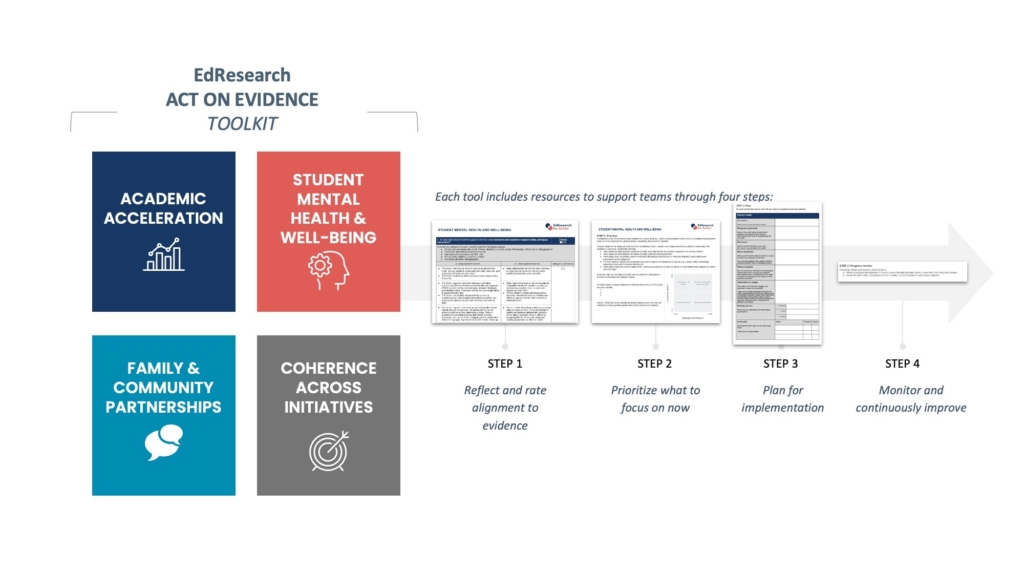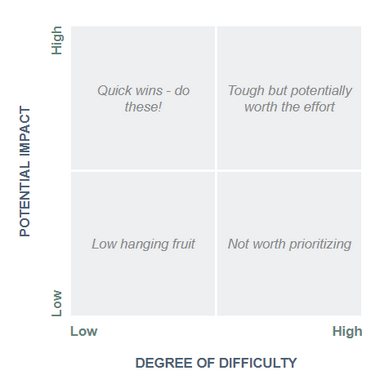Student Mental Health And Well-Being
About this Tool
This tool is part of the EdResearch Act on Evidence Toolkit which was created by EdResearch for Action1 in partnership with DeliverEd2 to support education leaders to assess the degree to which their existing programs are aligned with the relevant evidence-base and determine a pathway towards improving alignment and student success. While the toolkit is designed primarily for school and district leaders (e.g., Superintendents, Assistant Superintendents, Chief Academic Officers, and Principals), leaders at other levels of K-12 education (e.g., SEA leaders, policy-makers, advocacy groups, etc.) may find this tool helpful to understand the most critical, effective, evidence-based strategies to accelerate academic achievement.
This tool takes approximately 2 hours to complete. Remember very few (if any!) programs will meet all of the expectations for “strong alignment” so don’t be discouraged – strive to reflect as honestly as possible to best understand and plan for impactful next steps.

Table of Contents
STEP 1: Reflect and rate alignment to evidence
|
| STEP 2: Prioritize |
| STEP 3: Plan |
| STEP 4: Progress monitor |
Step 1: Reflect and rate alignment to evidence
Use the rubric below to capture reflection ratings and rationales based on the team’s assessment of your current alignment to evidence:
| STUDENT MENTAL HEALTH AND WELL-BEING | ||
| Strategy | Rating | Rationale |
| 1. Structures and systems to support safety, belonging, and culture | ? | |
| 2. Supports and strategies for SEL and well-being | ? | |
| 3. Monitoring students’ well-being | ? | |
| 4. Effective and proactive mental health interventions | ? | |
| 5. School-based staff provide evidence-based therapeutic support | ? | |





Step 2: Prioritize
Prioritization is key for successful implementation of recovery initiatives. Teams should prioritize where to focus on strengthening alignment based on what will provide the greatest impact, opportunity, and results for students.
Analyze: Based on the ratings and look-fors from the reflection rubric, consider which areas should be top priority to better align with evidence. In particular, consider the following:
- Which areas are least aligned to evidence currently, and might benefit the most from progress in the coming months?
- Which areas are most aligned with internal strategic goals and existing priorities?
- Which areas have the greatest need or would allow the greatest improvements in reducing inequities in performance and experiences across subgroups?
- For which areas or aspects do you already have district capacity and resources to execute (e.g., people, money, technology, stakeholder buy-in and or system momentum)?
- Which areas would you need to cadence first – either as required to be in place for others or would enable faster progress on others down the road?

If needed, map your top ideas on a chart like the one to the right based on the level of importance and difficulty of each.
Prioritize: Based on above, select up to three priorities to focus on for at least the next 6 months:
Review: Reflect and revise priorities as needed based on how well they will contribute to more equitable opportunities and/or outcomes for students.
STEP 3: Plan
For each priority listed above, work with your team to complete the planning roadmap:
| PRIORITY NAME | |||||
| Description What is this you are focused on doing? | |||||
| Rating and opportunity What is the current rating of alignment to evidence (per reflection rubric, above)?What opportunities exist for strengthening this over time? | |||||
| Root cause What is currently standing in your way? Why haven’t you achieved this to date? | |||||
| What it would take What would the district need to commit to, secure, or build to be successful in this work? *E.g., resources needed ($, tech, people); policies or practices to establish; skills or knowledge to acquire… | |||||
| Reduce inequities How will this priority contribute to more equitable opportunities and/or outcomes for students? What specific equity considerations will be taken into account to ensure this work results in more equitable outcomes? | |||||
| Stakeholders to engage Who needs to be informed, engaged, and supported to make this successful? *Make sure to consider stakeholders throughout the chain of people required to do the work: those involved in the design and decision making, those implementing and supporting, those possible or likely to block or resist the initiative, those with relevant expertise and/or resources, and the end users or recipients most affected by the initiative. | |||||
| Defining success What could you realistically and meaningfully accomplish in… | …6 months | ||||
| …1 year | |||||
| …3 years | |||||
| Action plan What specific action steps will you take to get there? *Add more rows if/as needed | Action | Timeline | Owner | ||
STEP 4: Progress monitor
Periodically (ideally each quarter), revisit this tool to:
- Reflect on progress and alignment of this priority using the reflection rubric above to determine if/how rating has changed.
- Revise the plan in Step 2 accordingly to further advance the work and ensure even stronger alignment.
1 For more see the EdResearch for Action briefs Assessing Students’ Social and Emotional Well-Being, Bringing Evidence-Based Decision-Making to School Safety, Preparing Schools to Meet the Needs of Students Coping with Trauma and Toxic Stress, and Structural Supports to Promote Teacher Well-Being; National Center for School Mental Health School Mental Health Quality Assessment – District Version; MA School of Mental Health Consoritum’s Five Guiding Principles for Building a Comprehensive School Mental Health System; EdSurge “Social-Emotional Learning Works. But it Cannot Replace Mental Illness Care.”.
2 EdResearch for Action is a joint initiative of Results for America and the Annenberg Institute at Brown University. EdResearch produces research briefs, runs practitioner networks, and engages relevant media to present and implement evidence-based recommendations for navigating pandemic response and recovery, and other ongoing challenges facing schools.
3 DeliverEd is an organization that helps education leaders deliver results for students at scale. DeliverEd supports results-focused strategic planning and implementation/progress monitoring..
4 For more see the EdResearch for Recovery Bringing Evidence-Based Decision-Making to School Safety brief.
5 For more see the EdResearch for Recovery Evidence-Based Practices for Assessing Students’ Social and Emotional Well-Being brief.
6 For more see the EdResearch for Recovery Preparing Schools to Meet the Needs of Students Coping with Trauma and Toxic Stress brief.